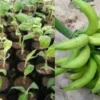- このトピックは空です。
- 投稿者投稿
- 3月 20, 2025 10:37 am #598227

Optimizing plantain yield and quality begins with strategic spacing. This fundamental agricultural practice significantly impacts resource utilization, disease management, and overall productivity.
Proper spacing ensures that each plant has adequate access to sunlight, nutrients, and water, fostering robust growth and maximizing fruit production. Let’s delve into the crucial aspects of plantain spacing techniques that contribute to a thriving plantation.
1. Determining Optimal Spacing
The optimal spacing for plantains varies depending on several factors, including the cultivar, soil fertility, and climate. Generally, a spacing of 3 meters between rows and 2 to 3 meters between plants within a row is recommended.
This allows sufficient room for plant growth and facilitates farm operations. High-density planting can increase yield in the short term, but it can also lead to competition for resources and increased disease pressure. Understanding the specific needs of the chosen plantain variety and adapting spacing accordingly is essential for maximizing yield.
2. Row Orientation and Layout
Row orientation plays a crucial role in maximizing sunlight interception. In regions with consistent sunlight, rows should be oriented north-south to ensure even light distribution throughout the day. In areas with prevailing winds, rows should be aligned to minimize wind damage.
The layout of the plantation should also consider accessibility for farm machinery and labor. Straight rows facilitate efficient weed control, fertilization, and harvesting. Careful planning of the layout is essential for optimizing resource utilization and streamlining farm operations.
3. Plant Density and Competition
Plant density directly affects competition for resources. High-density planting can lead to competition for sunlight, water, and nutrients, resulting in stunted growth and reduced yield. Conversely, excessively wide spacing can result in underutilization of land and reduced overall productivity.
Finding the right balance is crucial. Regular monitoring of plant growth and adjusting spacing as needed can help optimize resource utilization. Understanding how different plant densities influence the microclimate within the plantation is also important for managing disease and pest pressure.
4. Intercropping and Companion Planting
Intercropping and companion planting can be used to optimize land use and enhance plantain production. Intercropping with legumes, such as beans or cowpeas, can improve soil fertility and provide additional income. Companion plants can also help deter pests and diseases.
Careful selection of companion plants and proper spacing are essential for avoiding competition and maximizing the benefits of intercropping. Understanding the interactions between plantain and companion plants is crucial for successful intercropping practices.
5. Maintaining Spacing and Thinning
Maintaining proper spacing throughout the plantain’s life cycle is essential. This involves removing suckers that grow too close to the mother plant, a process known as thinning.
Thinning helps to reduce competition for resources and ensures that the main plant receives adequate sunlight and nutrients.
Regular monitoring of plant growth and timely thinning are crucial for maintaining optimal spacing and maximizing yield. Proper spacing also facilitates air circulation, reducing the risk of fungal diseases.
Strategic plantain spacing techniques are fundamental for achieving high yields and quality. By understanding the factors that influence optimal spacing, implementing proper row orientation and layout, managing plant density and competition, utilizing intercropping and companion planting, and maintaining spacing through thinning, farmers can create a thriving plantain plantation.
Read Also: What Crop Can Be Planted with Plantain?
- 投稿者投稿
- このトピックに返信するにはログインが必要です。






